9 Interesting Ways Edge of Tomorrow/Live. Die. Repeat. Differs from its Source Material
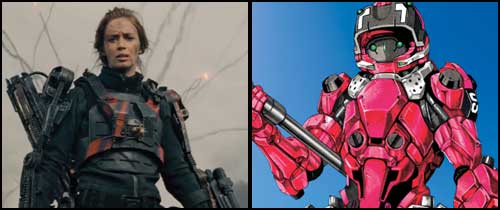 |
Today is a day which I fondly refer to as All You Need is Kills-mas, the day that Edge of Tomorrow comes out on DVD and Blu-ray. You know: Edge of Tomorrow, the Tom Cruise-Emily Blount science fiction spectacle that skidded hard at the box office, despite delighting both critics and the audiences who actually got out and saw it. Edge of Tomorrow, which plays like a sadistic Groundhog Day, as Cruise’s character dies over and over again, caught in a time loop, trying to somehow win a seemingly impossible battle. Edge of Tomorrow, inexplicably retitled Live Die Repeat after already being inexplicably retitled from its original moniker, the fabulous, can’t-forget-it-once-you’ve-heard-it All You Need is Kill. Edge of Tomorrow is notable for being an adaptation of a Japanese science fiction novel by Hiroshi Sakurazawa – Japanese SF isn’t something that’s commonly been mined for Hollywood blockbusters.
The thing is, the book and the movie were always going to have some differences. Even putting aside cultural switches, some material is always left out or tweaked. But what makes All You Need is Kill an interesting transmedia experience is that there’s also a damn good manga adaptation, drawn by Death Note and Bakuman star artist Takeshi Obata, plus an unusual American comics adaptation, written by Nick Mamatas and drawn by Lee Ferguson. All three adaptations work pretty well, but let’s break down some of their differences and see how the movie comes out against its source material. Naturally, this is gonna be a spoiler minefield, though I will say this: I won’t reveal the book’s final twist.
1) The Main Character Isn’t a Cowardly Middle-Aged PR Flack, But an Actual 20-Year-Old Recruit.
 |
In Edge of Tomorrow, the protagonist is Bill Cage, a propagandist for the United Defense Force, embroiled in a thorny and difficult land, sea, and air war to prevent the alien Mimics from overrunning Europe. An ill-timed difference of opinion with the UDF’s top general sees the aging Cage busted back down to private and sent to the front lines, to be strapped into one of the UDF’s cumbersome but somewhat effective Jacket armor suits – the same ones he’d spent the entire damn campaign making commercials for – and used as cannon fodder. Give the screenplay writers some credit – they got “Cage” from the original’s Keiji Kiriya. In Sakurazawa’s book, he is, like so many real-life military recruits, an aimless, worried 20-year-old. When Cruise optioned the book with plans to star in it, my first thought was, “How the hell is he going to play a green recruit?” Props to the film for doing it creatively, rather than trying to age Cruise down or rewrite the hero as a battle-hardened veteran.
2) Rita, the Full Metal Bitch, Is a Little Different.
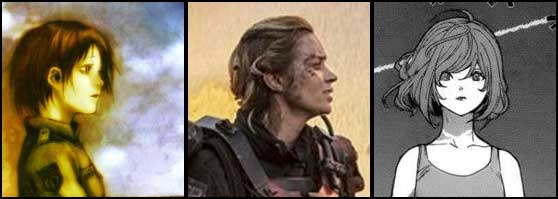 |
In the both the film and book, our hero meets Rita Vrataski, the “Full Metal Bitch” and star soldier of the UDF’s resistance, the same way – she pulls a spare battery off of his rapidly-dying corpse. But in the book, she notes his nationality, and asks him some weird questions about Japan – the lady knows how to make an impression. In the book, she’s American. In the film, she’s British. The movie also has her as a talented and gritty but not superhuman soldier, who’s won a series of key battles because she herself had gotten caught in a time loop. But in the book Rita really is that badass; she’s responsible for 50% of all Mimic kills on record (turns out she comes from a midwestern town that repelled a Mimic recon squad barehanded), and eschews the Jackets’ typical gun and pile-driver loadout in favor of a fearsome, eye-popping tungsten-carbide axe. And while her movie Jacket has red piping, in all other versions, the whole suit of armor is red, red, red. Which leads us into:
3) The Jackets Look Different, Too!
 |
This is one of the few things that disappointed me about the film, in comparison to other versions. Sakurazawa’s vision of the Jacket was always one of a full mecha suit, which envelops most of the user’s body in carbon-alloy armor and bristles with cool weapons. Obata takes the idea and runs with it in the manga, resulting in splendid mecha suits that look great in combat. Mamatas and Ferguson’s comic version is kind of a weird take on the material, ultimately resembling Iron Man’s comic-book getup rather than a precision, mass-produced military weapon. While I do think the movie’s open-face, half-armor Jackets are odd-looking, in the end they still work well onscreen – those shoulder-fired missile packs are pretty neat.
4) The Mimics Are a Little More Complicated in the Book.
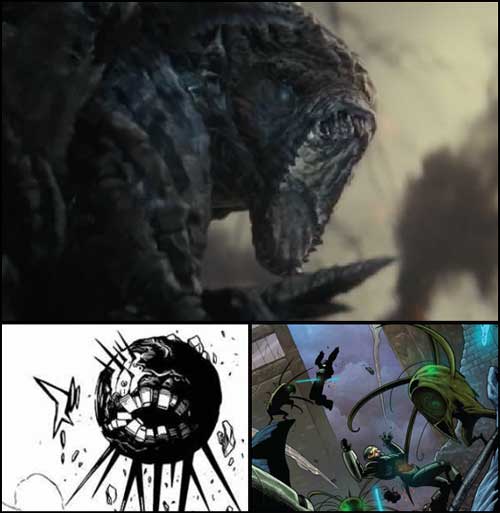 |
The movie’s version of the invading Mimic aliens is great! They’re lumpy, gape-mouthed, twitchy monsters that leap and bound across the battlefield, stabbing the shit out of hapless soldiers with their tentacles. In the book, they’re specifically described as kinda frog-faced, and similar in biology to starfish. They battle not with tentacles, but with terrifying javelins fired with devastating speed and accuracy directly from their bodies. The manga makes them a bit more abstract, kinda circular spiky things, and the comics version even moreso. One detail I like about the book: the earth forces have discovered that the Mimics are not truly an intelligent species, but a tool used by a higher and more remote alien race – when they’re not annihilating Earth forces, the Mimics eat earth soil and spit out toxic crap, the better to terraform our world for their remote masters’ use. That little detail was obviously gonna be difficult to fit into the movie’s scope, so I’m not too put out that it wasn’t included.
5)Some Characters Only Appear in the Book. Other Characters Only Appear in the Movie.
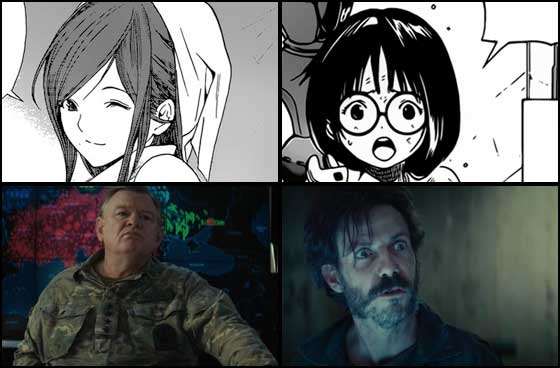 |
Brendan Gleeson’s hulking, glaring General Brigham makes for a really fun secondary antagonist – he’s the one who deep-sixes Cage to the front lines, and when Cage gets stuck in the loop and realizes that the Mimics are using it as a weapon to plan a huge ambush, it’s Brigham who stodgily refuses to believe him. There’s no trace of him in the book, though. Instead – and these characters also appear in Obata’s manga, which is what you see above – we get a couple of weirdly cute support personnel in the form of Rachel Kisaragi, a kitchen worker who befriends Kiriya on the eve of the battle; and Shasta Rayle, whom the American comics describe as “Rita’s personal nerd,” a scientist who develops new weapons and technology for Rita’s unique Jacket.
In the book, it’s Shasta who points out that the Jacket is more effective with its autobalancer turned off, even though it means you pretty much have to learn to walk again. Kiriya also bribes her for a tungsten axe of his own, which doesn’t make it to the movie either. Picture that: a huffing, sweaty, dirty Tom Cruise swinging a giant metal axe. Couldn’t they have included it as a DVD extra, at least?! Instead of Shasta, the film gives us the wild-eyed Noah Taylor as Dr. Carter, whose bag is more alien biology than mecha superweapons.
6) The Totally Awesome Bill Paxton Character Is a Very Different – But Still Pretty Awesome – Character.
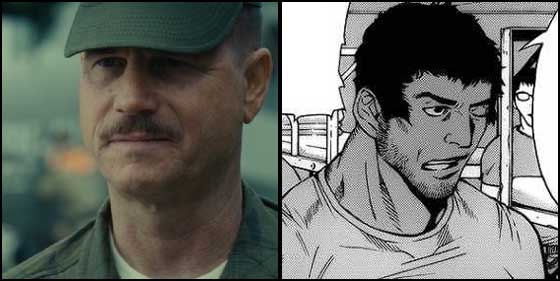 |
Seemingly everyone who got out to see Edge of Tomorrow praised Bill Paxton’s turn as the laconic, jaded master sergeant in charge of Cage’s unit. When Cage querulously asks the seargent, Farrell, if he’s American, Paxton quips “No, sir. I’m from Kentucky.” The Kentuckian Sgt. Farrell is based on the book’s Sgt. Ferrell Bartolome, a Brazilian-Japanese veteran who starts the story as a similar hardass, quickly giving Kiriya and his pals physical training punishment for an ill-fated drinking expedition the night before. But after Kiriya finds himself in the loop, Bartolome dishes out advice and training to the increasingly desperate young soldier generously. Paxton’s Sergeant doesn’t want to hear Cruise’s bullshit, but Bartolome takes Kiriya’s urgent request for specialized combat training in stride. When the shit hits the fan, they’re tough and brutal battle buddies – but to Kiriya’s immense frustration, Bartolome is one soldier he can never seem to save in his many trips through the time loop.
7) A Single Character from the Book is Turned Into an Entire Squad in the Film.
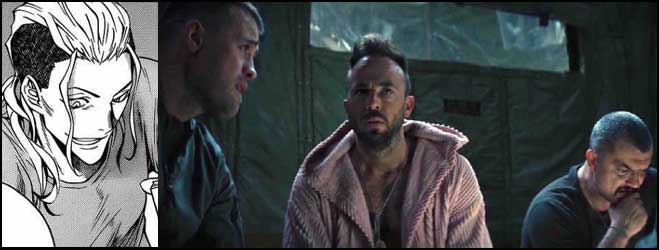 |
Another of Sakurazawa’s companions for Kiriya is Yonabaru, his bunkmate at the barracks. The other man is there mainly for Kiriya to have someone to talk to in the moments between the big plot points, dishing out information about Rita and the war at key moments. The movie takes that single character and turns him into an entire multinational fighting force, with a weirdo in a Hawaiian shirt, a weirdo who paints up his Jacket to look like a skeleton, and a tough-talkin’ lady weirdo. I don’t mind this change, either – in the film’s final battle, Cage and Vrataski need all the help they can get, and the squadmembers provide a lot of it.
8) Child Murder.
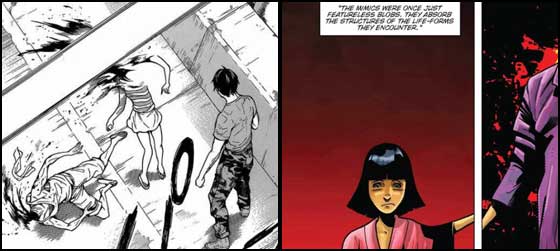 |
A neat feature of Edge of Tomorrow is the many, many ways we get to see Tom Cruise die. After a multitude of trips through the time loop, he realizes that he’s pretty much doomed to die in the same battle indefinitely, so he tries to leave the base. He ends up in a London pub, only to be killed once again by an unexpected incursion of the Mimics. This mirrors a bit in the book, also realized all-too-vividly in the manga and comics, where Kiriya escapes the base and takes refuge on a nearby bridge. He’s outside of Tokyo, in an area the Mimics haven’t yet overrun, talking to an old dude and his granddaughter. The Mimics pretty much appear out of nowhere and kill everyone in sight.
This is actually not 100% gratuitious – Kiriya later learns that the Mimics know he’s able to use the time loop against them, and are targeting him – but you know that it was never going to make it into the Cruise film. After all, most Hollywood movies will shy away from graphic child murder, which doesn’t do well with test audiences. I can’t imagine why not!
9) The Ending’s a Bit More Downbeat Than the Film Version.
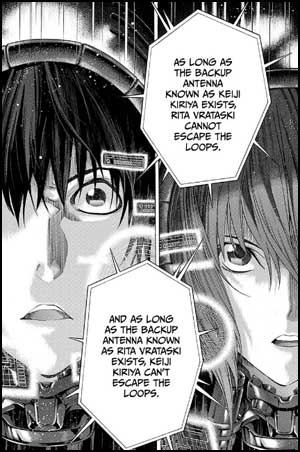 |
Did you think the movie wrapped up just a little too neatly? So did lead screenplay writer Christopher McQuarrie, who reportedly had a different ending in mind. In his take, one of Cage’s squadmates, in their big ambush at Paris, inadvertently kills an Alpha Mimic, resetting the time loop against the UDF’s favor – meaning that we go back to the gang in the helicopter, with Cage urgently explaining the big master plan, right before the chopper gets violently shot down. Aaaand, roll credits!
Dark, right? Once the film’s weird sense of humor became evident, a new ending was needed. But Sakurazawa’s ending is even more brutal. The film’s “alpha” terminology isn’t used – instead, Kiriya and Vrataski learn that some Mimics are “servers,” which remember failed battles and send a tachyon warning backwards in time, which is how Kiriya got caught in the loop in the first place. These Servers are backed up by adjuncts to the loop, known as Antennas. Since Kiriya killed a Server right as he was dying, he’s an Antenna, who takes the same trip back in time and gets the same do-over. But because of her proximity, Rita herself is also an antenna – and the only way to close the time loop for good and win the battle is for her and Keiji to fight each other, with only one left standing. How does that turn out? Not everyone lives, that’s for sure. You can read the book for the details.
In spite of the many minor and moderate changes, I think the “meat” of Hitoshi Sakurazawa’s story, a hapless recruit who gradually learns to win an unwinnable battle over countless deaths, is both intact and presented very appealingly in Edge of Tomorrow. Against my expectations, Cruise and Blount, plus director Doug Liman, screenwriter McQuarrie, and the rest of the gang, made a damn good movie. It was physically uncomfortable to watch it lurch haltingly to a middling $100 million domestic box office take, not merely because it’s a fine film, but because Cruise has optioned Chohei Kanbayashi’s classic SF aerial dogfighting epic, Yukikaze, for development. After seeing Edge of Tomorrow, I’m confident he could get a good movie version of Yukikaze made. But given Edge of Tomorrow’s lackluster performance, that’s one alternate ending we might not get to watch.
 |
One thing sticks in my craw, though: that title. Edge of Tomorrow isn’t that bad, but there’s already an Isaac Asimov book with that name, dammit. Live, Die, Repeat is actually a step down, if you ask me. I’m all for the original title, which is why I’m probably gonna end up buying the Japanese Blu-ray pictured above. There’s one last difference for you! If it’s got any cool Japan-only extras, I’ll be sure to let you all know.
Previously by Mike Toole:
Nine Surprising Ways the Original Oldboy Manga Differs from the Korean Film
